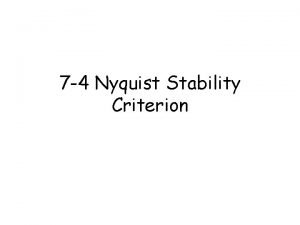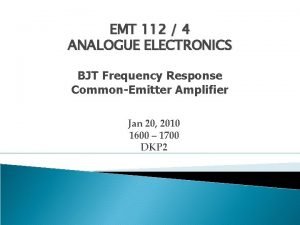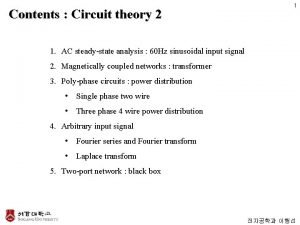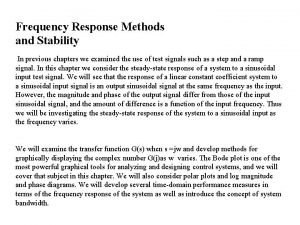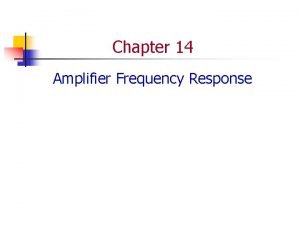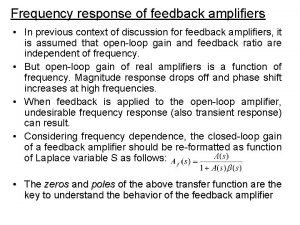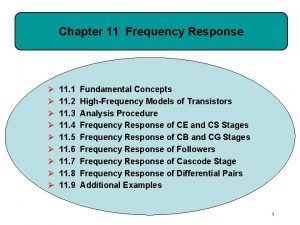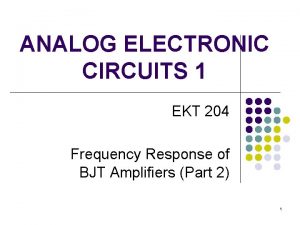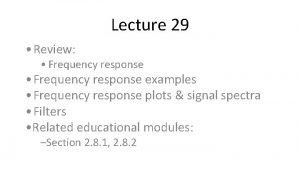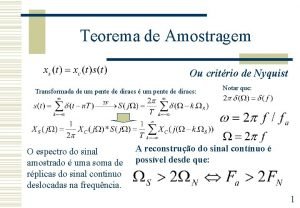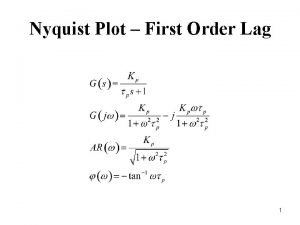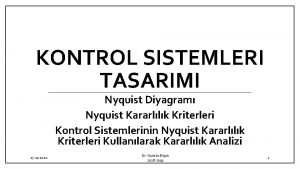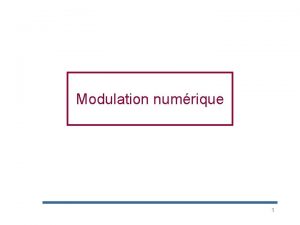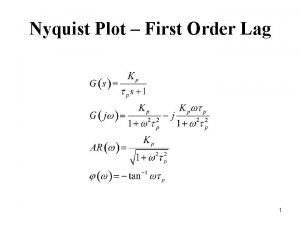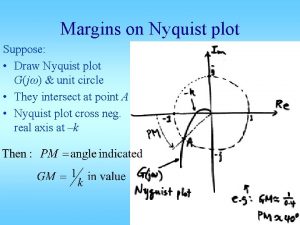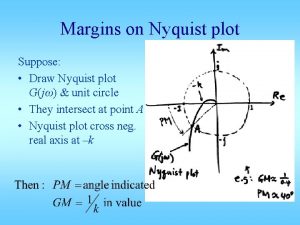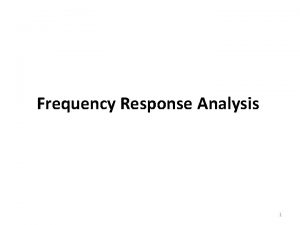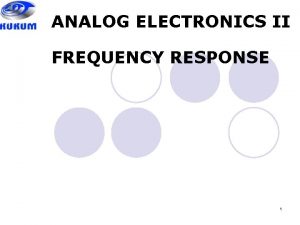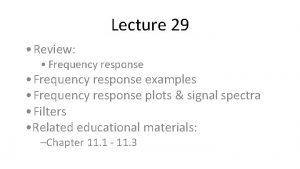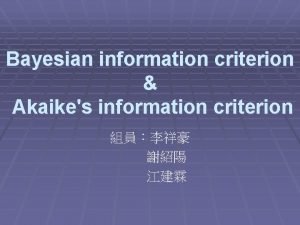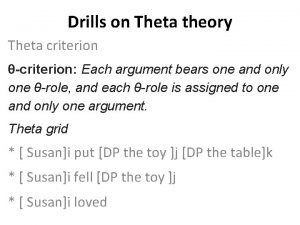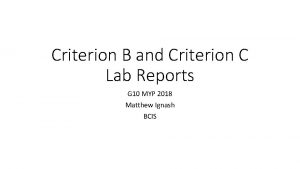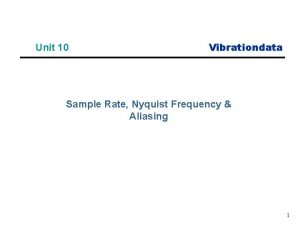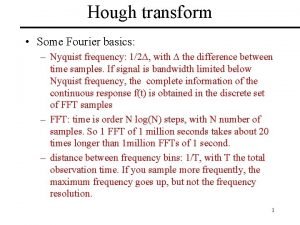The Nyquist Criterion A Frequency Response Analysis Technique





































- Slides: 37

The Nyquist Criterion A Frequency Response Analysis Technique

Nyquist Plot or Polar Plot • Nyquist Plots were invented by Nyquist - who worked at Bell Laboratories, the premiere technical organization in the U. S. at the time. • Nyquist Plots are a way of showing frequency responses of linear systems. • There are several ways of displaying frequency response data, including Bode' plots and Nyquist plots. • Bode' plots use frequency as the horizontal axis and use two separate plots to display amplitude and phase of the frequency response. • Nyquist plots display both amplitude and phase angle on a single plot, using frequency as a parameter in the plot. • Nyquist plots have properties that allow you to see whether a system is stable or unstable.

Nyquist Plot • A Nyquist plot is a polar plot of the frequency response function of a linear system. • That means a Nyquist plot is a plot of the transfer function, G(s) with s = jω. That means you want to plot G(j ω). • G(j ω) is a complex number for any angular frequency, ω, so the plot is a plot of complex numbers. • The complex number, G(j ω), depends upon frequency, so frequency will be a parameter if you plot the imaginary part of G(j ω) against the real part of G(j ω).

Sketch the Polar plot of Frequency Response To sketch the polar plot of G(jω) for the entire range of frequency ω, i. e. , from 0 to infinity, there are four key points that usually need to be known: 1) The start of plot where ω = 0, 2) The end of plot where ω = ∞, 3) Where the plot crosses the real axis, i. e. , Im(G(jω)) = 0, and 4) Where the plot crosses the imaginary axis, i. e. , Re(G(jω)) = 0.

Problem-1: Polar Plot of Integrator Consider a first order system, Representing G(s) in the frequency response form G( jω ) by replacing s = jω: The magnitude of G( jω ), i. e. , | G( jω) |, is obtained as; The phase of G( jω ), denoted by, φ , is obtained as; Bode Plot Magnitude Phase Polar Plot

Problem-2: Polar Plot of First Order System Consider a first order system where T is the time constant. Representing G(s) in the frequency response form G( jω ) by replacing s = jω: The magnitude of G( jω ), i. e. , | G( jω) |, is obtained as; The phase of G( jω ), denoted by, φ , is obtained as;

The start of plot where ω = 0 The end of plot where ω = ∞ The mid part of plot where ω = 1/T

Bode Plot Magnitude Phase Polar Plot

Problem-3: Polar Plot of Second Order System Consider a second order system where T is the time constant. Representing G(s) in the frequency response form G( jω ) by replacing s = jω: The magnitude of G( jω ), i. e. , | G( jω) |, is obtained as; The phase of G( jω ), denoted by, φ , is obtained as;

The start of plot where ω = 0 The end of plot where ω = ∞ Polar Plot

Problem-4: Sketch the Nyquist diagram for the system shown in the following figure, and then determine the system stability using the Nyquist criterion. (a)

Now that we have expressions for the magnitude and phase of the frequency response, we can sketch the polar plot using the 4 key points. Point 1: The start of plot where ω = 0

Point 2: The end of plot where ω = ∞ Point 3: Where the plot crosses the real axis, i. e. , Im(G(jω)) = 0 Take the imaginary part of equation (a), and put equal to zero, to get the value of frequency ω at the interception of real axis.

Point 4: Where the plot crosses the imaginary axis, Re(G(jω)) = 0 Take the real part of equation (a), and put equal to zero, to get the value of frequency ω at the interception of imaginary axis.

Problem-5: Sketch the polar plot for the following transfer function. Representing G(s) in the frequency response form G( jω ) by replacing s = jω, and then Multiply both numerator and denominator by the conjugate of denominator. (a)

Point 1: The start of plot where ω = 0 At frequency ω = 0, we only observe the most significant terms that take the effect. Magnitude at ω = 0: Phase at ω = 0: Point 2: The end of plot where ω = ∞ At frequency ω = ∞, we shall look at the most significant term that takes effect when the frequency approaches infinity. Magnitude at ω = ∞: Phase at ω = ∞:

Point 3: Where the plot crosses the real axis, i. e. , Im(G(jω)) = 0 Take the imaginary part of equation (a), and put equal to zero, to get the value of frequency ω at the interception of real axis.

Point 4: Where the plot crosses the imaginary axis, Re(G(jω)) = 0 Take the real part of equation (a), and put equal to zero, to get the value of frequency ω at the interception of imaginary axis. Polar Plot |G(jω)| ∠G(jω) ω=0 ∞ -90 o ω=∞ 0 -270 o 0

Problem-6: Sketch the polar plot for the following transfer function. Representing G(s)H(s) in the frequency response form G( jω )H(jω) by replacing s = jω: The magnitude of GH(jω) i. e. , |GH(jω)|, is obtained as;

Point 1: The start of plot where ω = 0 Point 2: The end of plot where ω = ∞ Polar Plot |GH(jω)| ∠GH(jω) ω=0 ∞ 0 o ω=∞ 0 -90 o




Four Important Points for Derivation the Nyquist Criterion 1. The relationship between the poles of 1 + G(s)H(s) and the poles of G(s)H(s); 1. The relationship between the zeros of 1 + G(s)H(s) and the poles of the closedloop transfer function, T(s); 2. The concept of mapping points; 3. The concept of mapping contours.

It is conclude that; 1) The poles of 1 + G(s)H(s) are the same as the poles of G(s)H(s), the open-loop system. 2) The zeros of 1 + G(s)H(s) are the same as the poles of T(s), the closed-loop system.

The Concept of Mapping • If we take a complex number s = x+jy on the s-plane and substitute it into a function, F(s), another complex number results. This process is called mapping. OR • The term mapping is defined as the substitution of a complex number into a function, F(s), to get another complex number. • For example, substituting s = 4 + j 3 into the function F(s) = (s 2 +2 s + 1) yields 16+j 30. We say that 4 + j 3 maps into 16+j 30 through the function s 2 +2 s + 1.

The Concept of Mapping Contours The collection of points, called a contour.

Examples of Contour Mapping If we assume a clockwise direction for mapping the points on contour A, the contour B maps a clockwise direction if F(s) has just zeros or has just poles that are not encircled by the contour.

Examples of Contour Mapping The contour B maps in a counter clockwise direction if F(s) has just poles that are encircled by the contour, Also, you should verify that, if the pole or zero of F(s) is enclosed by contour A, the mapping encircles the origin.

Examples of Contour Mapping In this last case, the pole and zero rotation cancel, and the mapping does not encircle the origin.

THE NYQUIST STABILITY CRITERION • A linear closed-loop continuous control system is absolutely stable if the roots of the characteristic equation have negative real parts. • Equivalently, the poles of the closed-loop transfer function, or the zeros of the denominator, 1 + GH(s), of the closed-loop transfer function, must lie in the left-half plane. • The Nyquist Stability Criterion establishes the number of zeros of 1 + GH(s) in the right-half plane directly from the Nyquist Stability Plot of GH(s).

Nyquist Stability Criterion The closed-loop control system whose open-loop transfer function is GH is stable if and only if Where, N = total number of CW encirclements of the (-1, 0) point (i. e. , GH = - 1 ) in the GHplane. Po = number of poles of GH in the right-hand-plane RHP for continuous systems. If N > 0, the number of zeros Zo of 1 + GH in the RHP for continuous systems, is determined by If N ≤ 0 and Po = 0, then the system is absolutely stable if and only if N = 0; that is, if and only if the (-1, 0) point does not lie in the shaded region.

Problem-7: Sketch the polar plot for the following transfer function and check the stability of the system. There is one pole at the origin. Representing G(s)H(s) in the frequency response form G( jω )H(jω) by replacing s = jω: The magnitude of GH(jω) i. e. , |GH(jω)|, is obtained as;

Point 1: The start of plot where ω = 0 Point 2: The end of plot where ω = ∞ Polar Plot |GH(jω)| ∠GH(jω) ω=0 ∞ -90 o ω=∞ 0 -180 o

Nyquist or Polar Plot Nyquist Diagram

• The region to the right of the contour has been shaded. • Clearly, the (-1, 0) point is not in the shaded region; therefore it is not enclosed by the contour and so N ≤ 0. • The poles of GH(s) are at s = 0 and s = -1, neither of which are in the righthand-plane RHP; hence Po = 0. Thus N = -Po = 0, and the system is absolutely stable.

Problem-8: The Nyquist Stability Plot for GH(s) = 1/s(s-1) is given in the figure below. • The region to the right of the contour has been shaded and the (-1, 0) point is enclosed; then N > 0. (It is clear that N = 1). • • The poles of GH are at s = 0 and s = +1, the latter pole being in the RHP. Hence Po = 1. • N ≠ Po indicates that the system is unstable. • Z = N + Po = 1 + 1 = 2, therefore the poles of the closed-loop transfer function, or the zeros of the characteristic equation 1+GH in the right-hand plane RHP.
 Nyquist criterion for distortionless transmission
Nyquist criterion for distortionless transmission Nyquist criterion determine stability of
Nyquist criterion determine stability of Nyquist stability criterion
Nyquist stability criterion Marginal relative frequency
Marginal relative frequency Observed frequency
Observed frequency Form factor formula
Form factor formula Vmax=aw
Vmax=aw Relative frequency bar chart
Relative frequency bar chart Joint frequency vs marginal frequency
Joint frequency vs marginal frequency Marginal relative frequency
Marginal relative frequency Cutoff frequency formula
Cutoff frequency formula Multistage amplifier applications
Multistage amplifier applications Circuit theory 2
Circuit theory 2 High frequency model of bjt
High frequency model of bjt Frequency response methods and stability
Frequency response methods and stability Frequency response curve of an amplifier
Frequency response curve of an amplifier Formula for cutoff frequency
Formula for cutoff frequency Bjt frequency response
Bjt frequency response Frequency response of feedback amplifier
Frequency response of feedback amplifier Source follower frequency response
Source follower frequency response Frequency response cbe
Frequency response cbe Mti versus pulse doppler radar
Mti versus pulse doppler radar Frequency response
Frequency response Natural response and forced response
Natural response and forced response Natural and forced response
Natural and forced response A subsequent
A subsequent Psychosocial factors examples
Psychosocial factors examples Relaxation response technique
Relaxation response technique Relaxation response technique
Relaxation response technique Wolfram nyquist
Wolfram nyquist Teorema de nyquist
Teorema de nyquist How to draw nyquist plot
How to draw nyquist plot Nyquist
Nyquist Nyquist kararlılık kriteri
Nyquist kararlılık kriteri Nyquist teoremi
Nyquist teoremi Anders nyquist
Anders nyquist Bande de nyquist
Bande de nyquist Bande de nyquist
Bande de nyquist

